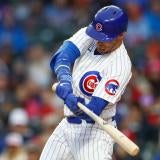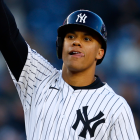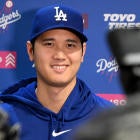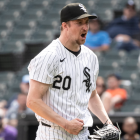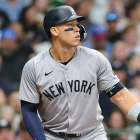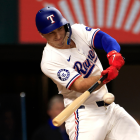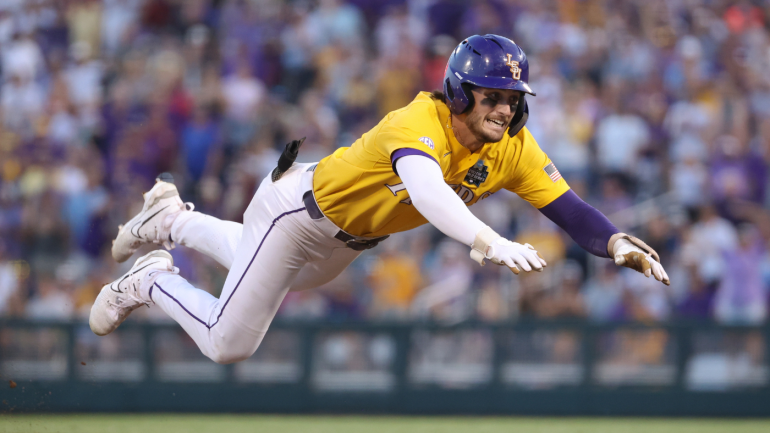
Major League Baseball's first-year player amateur draft has arrived. As is the new custom, the event will kick off alongside MLB's All-Star Game festivities on Sunday, July 9. The 20-round draft will then continue on Monday before reaching its conclusion on Tuesday, ahead of the actual All-Star Game.
CBS Sports has been covering the draft from all angles over the last month. That includes our annual top-30 rankings, which you can see in full below. These rankings, originally published in mid-June, were compiled through conversations with scouts, analysts, and player development specialists, as well as firsthand observation and research into data and historical trends.
The rankings blend two matters: 1) where each player should go, based on their talent; and 2), where each player will go, based on the latest industry gossip. This is, as you'd imagine, an imperfect science and we request you to keep error bars in mind as you scroll through the list. We would also encourage you to remember that all 30 of these players are talented, and are in line to make good money as professionals. And as a reminder, here's the order of teams picking, based on the winter lottery.
Before we get to the rankings, we'd also encourage you to check out some of our additional draft content:
- Potential risers
- Potential fallers
- The risky history of pitchers selected No. 1 overall
- The last 10 No. 1 picks
- What the Pirates' history suggests they may do at No. 1
With that out of the way, let's get to it.
1. Dylan Crews, OF, LSU
Some years ago, Microsoft constructed the anechoic chamber, or what they contend is the world's quietest room. Occupying the chamber is said to be excruciating: there's a certain existential dread triggered by hearing one's innermost machinery beat, click, and creak away. Still, you can't blame any pitcher who would prefer an afternoon in there to another round against Crews, who spent the spring reinforcing pitchers' mortality in other ways by slashing .405/.545/.685 with more walks than strikeouts in SEC play.
Dylan Crews, ladies and gentlemen@__dc4__ | ESPN+ pic.twitter.com/45jI2b9knj
— LSU Baseball (@LSUbaseball) June 4, 2023
He hits the ball hard and often, as you would expect, and he commands the strike zone. Some evaluators believe he could develop 70-grade hit and power tools, a (likely overzealous) projection that would make him an elite batter. He should begin his professional career in center field, too, even if he moves to a corner before reaching the majors. A veteran scout told CBS Sports in the spring that Crews was the most obvious top pick since Bryce Harper in 2010. Nothing has happened since to change that outlook. The Pirates may run the same play they did in 2021, when they drafted Louisville catcher Henry Davis No. 1 and distributed the money they saved on his underslot signing bonus elsewhere in their class, but if talent and talent alone is the determinant then the pick is Crews.
2. Wyatt Langford, OF, Florida
Somewhere in Existence, there's an alternate timeline that's much like our own except for one detail: the COVID-19 pandemic never occurred. (Small beans, huh?) There, Dylan Crews was allowed to play out his high school senior season, during which he raised his stock and turned professional. Langford, then, is the draft's No. 1 prospect. Instead of being compared to Crews, he would be praised as a much better prospect than some recent No. 1 picks, like Henry Davis and Spencer Torkelson. In case it needs to be written: that last part is true in this universe, too. Langford is coming off a phenomenal season that saw him hit .350/.484/.720 with one fewer walk than strikeout against SEC competition. He projects to have plus or better hit and power tools despite an unorthodox swing that features minimal hand load and him striding into the bucket. He pairs those traits with an oft-praised approach and sneakily above-average footspeed (though he stole only 13 bases during his collegiate career). During the preseason, a veteran evaluator gave him a coin flip's chance of sticking in center field for the long haul. It's at least worth starting him there and seeing if he can handle it. Langford is going to be a highly positive value pick wherever he's selected.
3. Walker Jenkins, OF, South Brunswick HS (NC)
Jenkins, a North Carolina commit, is the least famous of the top four outfielders in this class. Luckily for him, fame isn't considered one of the five tools -- and his game contains most of what is. His pretty left-handed swing showed no residual effects from the broken hamate bone he suffered last summer, allowing scouts to project him as a potential middle-of-the-order hitter. He has a good feel for contact and the strike zone alike, and his sturdy 6-foot-3 frame should enable him to add muscle and potentially push his raw power up to a 70-grade projection. Jenkins is all but certain to move to a corner, likely right field, where his strong arm can keep baserunners honest. In other words, him ranking third among outfielders speaks more to the unusual top-end depth at the position in this class than to any real deficiency on his part.
4. Max Clark, CF, Franklin Community HS (IN)
Other teams have identified Clark as the likeliest option for the Pirates at No. 1 if they again employ the portfolio approach. He would be a defensible pick there most years: a certain center fielder with a strong arm and real offensive upside bolstered by a fast left-handed bat. One scout compared Clark, a Vanderbilt commit, favorably with Cubs outfielder Pete Crow-Armstrong, one of the 25 best prospects in the minors. Some evaluators have dinged him because of the lackluster competition he faced in Indiana. That belief, in turn, has created the perception that the error bars are markedly wider on his offensive projections than they are with the other top outfielders. It's a fair consideration, but keep in mind that certainty is for the funeral director and the taxman, not the baseball scout. That means Clark is still likely to come off the board within the top five.
5. Paul Skenes, RHP, LSU
Skenes is an imposing figure with upper-90s velocity and a strikeout rate near 48% against SEC hitters. About 15 years ago, that would've been enough to land him higher on this list (and the belief is he might go as early as No. 2 overall, with several sources identifying him as the Nationals' kind of pitcher). Those within the industry are convinced that ball-tracking data has improved their ability to evaluate pitches. Those advancements have made Skenes a divisive figure, with scouts and analysts who spoke to CBS Sports expressing reservations about his fastball shape. The short version is that his four-seamer features minimal separation between its induced vertical break and its horizontal break, putting it in the "dead zone." The fear is Skenes' four-seamer will play down as a result, causing him to underperform draft night expectations. Consider Nathan Eovaldi, another big-armed righty with minimal separation; prior to this year, opponents had hit .300 or better against his fastball in three consecutive seasons. Skenes' velocity may mitigate some of the effect, and it's possible his employer will help him find a better shape, or will have him shift to his sinker (his current one features more run than Dustin May's).
Happy Paul Skenes Day!@Paul_Skenes | ESPNU pic.twitter.com/L57tH88Id2
— LSU Baseball (@LSUbaseball) June 2, 2023
Factor in the probabilistic analysis argument that arises whenever a pitcher is part of a class loaded with good hitters, and that's why he's lower than you might have expected, even if he still goes No. 2.
6. Arjun Nimmala, SS, Strawberry Crest HS (FL)
This class is often presented as being five players deep. Nimmala, a Florida State commit, is the best candidate to render that framing incorrect. He won't celebrate his 18th birthday until October ("Wedding Crashers" had been in theaters for months by the time he was born), making him the youngest of the top 10. His game is full of promise, beginning with the smooth actions and above-average arm strength that should keep him at short for the long term. At the plate, Nimmala makes loud contact with a simple swing. His lean frame suggests he should be able to pack on muscle in the coming years, at which point he could earn a plus power projection. He's not going to be quick to rise -- whatever team selects him should do so knowing that maximizing his game, particularly his bat, means taking the low and slow developmental approach -- but in a lesser draft he would be slotted in higher than this.
7. Kyle Teel, C, Virginia
A collegiate backstop has been selected in the first half of round one in each of the past five drafts. Teel, the ACC's Player of the Year, should extend that streak to six. He's a high-quality athlete who saw action in the outfield earlier in his collegiate career. His future is very much behind the plate, where he wields a strong arm with an understanding of how to manipulate his body to best present pitches. Offensively, Teel recovered from a rough cameo in last summer's Cape Cod League, solidifying himself as the best catcher in the class by hitting .366 with a 14.4% strikeout rate in conference play.
8. Chase Dollander, RHP, Tennessee
Marcel Proust wrote that sorrow develops the powers of the spirit. Dollander should be leveled-up, then, following a tough spring that saw him drop from the unanimous top pitcher in the class to perhaps as low as third or fourth, depending on the judge. Dollander threw one fewer inning this season than he did last, yet he allowed six more home runs and 14 more walks as he battled his command all spring. He also employed an altered slider compared to the one scouts were fond of the previous year, with the new slider featured about half as much sweep, as well as additional backspin. Through it all, Dollander (and his strengthened spirit) remains an interesting enough pitching prospect with a high enough ceiling to warrant top-10 consideration.
9. Enrique Bradfield, CF, Vanderbilt
Bradfield is an elite ballhawk in center field who ought to compete for a Gold Glove Award in due time. He's also a top-notch baserunner who could steal more than an AI generator (he swiped 130 bases at a 91% success rate for his collegiate career). At the plate, he has a disciplined approach and a good feel for contact that allowed him to bat .296 with more walks than strikeouts in SEC play. While he's never going to be a power hitter, his average and top-end exit velocities were more impressive than, say, Jacob Wilson's. Still, Bradfield was the most polarizing position player in the class among the scouts and analysts who spoke to CBS Sports.
EBJ's speed 🤯#VandyBoys | #AnchorDown pic.twitter.com/nn0d8UPGyo
— Vanderbilt Baseball (@VandyBoys) May 26, 2023
One veteran scout said they would not touch Bradfield in the first two rounds. Their reason was that players of his ilk can be found later in the draft. There's truth to that based on a survey of the top defensive center fielders going: Harrison Bader was a third-round pick; Myles Straw and Jake Meyers were taken in the 12th and 13th; and Kevin Kiermaier lasted all the way until the 31st. Other evaluators have pointed out that getting any of those players in the first round would be a fine outcome. We think the second school of thought will prevail, and that Bradfield will be selected within the first 10 picks.
10. Chase Davis, OF, Arizona
We didn't rank Davis in the spring on account of his woeful in-zone contact rate -- you have to be able to hit strikes to make it in the pros. He clearly recognized that flaw in his game and worked to level up. He succeeded, greatly improving his in-zone contact rate and reducing his overall strikeout rate from 22.8% to 14.8%. The rest of Davis' game required no tinkering. He has good strength (stemming from a swing that has and will continue to earn him comparisons to Carlos González) and a firm command over the strike zone. He's also athletic enough to profile as an above-average defender in right. Some teams will have reservations about whether or not Davis' gains will stick, but let's face it: every draft pick requires a leap of faith. At least this one includes the possibility of landing a good right fielder.
11. Matt Shaw, INF, Maryland
Shaw is one of several collegiate infielders likely to come off the board in the teens. He's a well-rounded player who walked more than he struck out this season while also setting new career-highs in home runs and stolen bases. The determinant on when he goes will be his expected position. A few scouts have expressed to CBS Sports the belief that he should at least begin his career at shortstop, but there's a camp who believes his arm is too light for the left side. Even if Shaw ends up at second base, his collection of average or better offensive tools should make him appealing
12. Tommy Troy, INF, Stanford
Troy is a compact athlete who bounced around the infield during his time at Stanford, manning third this year after having previously seen most of his action at second base and shortstop. Where, precisely, teams view him playing as a professional (the keystone tends to win the straw polls) will dictate his landing spot in the first round. Offensively, Troy showed a lot of growth this spring, posting career-best walk and strikeout rates as well as swiping 17 bags after taking just eight in his first two seasons combined.
13. Colin Houck, SS, Parkview HS (GA)
Houck, also a well-regarded quarterback prospect, hails from the same Georgia school that produced big-leaguers Matt Olson, Jeff Francoeur, and Jeff Keppinger. It's easy to see his name joining that collection someday soon. He's a well-rounded shortstop with a no-frills swing and good bat speed. We mentioned in the spring that teams are often willing to let players with this profile do their thing in college before they use a first-round pick on them. Houck, a Mississippi State commit, has done enough to earn an express ticket to pro ball.
14. Hurston Waldrep, RHP, Florida
Waldrep, whose name belongs in a Pynchon novel, didn't make as smooth of a transition to the SEC as Skenes did, but he remains a tantalizing prospect with compelling raw traits. Waldrep continued to show off swing-and-miss stuff, including a fastball that has been clocked into the upper-90s and an elite splitter. He posted a 30% strikeout rate and a 56% ground ball rate during conference play to prove that everyone is equal in the eyes of the rocket, though his walk rate swelled to an unimaginable 14.3% against SEC foes. (No qualified MLB starter this season has walked more than 13.2%.) Waldrep has to manipulate his spine to achieve his over-the-top arm slot, and it's possible he never boasts even average command as a result. There's an incredible amount of upside to be unlocked here if he lands in the right organization, and an equal amount of downside to be found if he lands in the wrong one.
15. Rhett Lowder, RHP, Wake Forest
Wake Forest has its own pitching laboratory and biomechanics staff, making it arguably the best program in the country at developing arms. Sure enough, they've produced two (and soon to be three) top-30 hurlers since 2020. Lowder, for his part, ought to become the highest Demon Deacon pitcher selected since Kyle Sleeth went No. 3 overall in 2003. He's a polished right-hander with a quality four-pitch mix, including a pair of low-to-mid-90s fastballs and a good changeup. Lowder has plus control and this season he generated more than 50% grounders for the first time in his collegiate career. He might not have the loftiest ceiling -- in part because he's already optimized his game at Wake Forest -- but he should go in the top half of round one and move quickly from there.
16. Noble Meyer, RHP, Jesuit HS (OR)
Meyer is the best prep pitcher in the class, but it comes at a time when teams are wary of selecting high-school righties in the early stages of the draft (on account of their unkind attrition rates). He checks all of the boxes. He has a tall, projectable frame and a delivery that looks effortless, especially given the fact that his arm action is longer than that sentence from Ducks, Newburyport. Meyer's fastball has been clocked into the upper 90s and he has a pair of promising breaking balls, including a sweeping slider. Where he goes in the first round just depends on any given team's appetite for risk. (For those wondering, the Phillies, who have won similar bets in recent years on Mick Abel and Andrew Painter, do not select until pick No. 27.)
17. Kevin McGonigle, SS, Monsignor Bonner HS (PA)
McGonigle's top selling point is his polish. He has a simple swing and has demonstrated he can barrel the ball and control the zone with consistency. That combination bodes well for his hit tool playing as at least above-average at the next level. Defensively, McGonigle is a compact athlete without the kind of explosiveness often seen at shortstop. He has good hands and receives high marks for his baseball acumen, suggesting he could be an asset at second base. As a guidepost: Nick Yorke went 17th in 2020 with a similarish profile. McGonigle has a commitment to Auburn, but don't expect him to honor it.
18. Walker Martin, SS, Eaton HS (CO)
Martin, an Arkansas commit, hits from the left side and ought to field there too thanks to good arm strength. He's listed at 6-foot-2 and has the kind of projectable frame (think Ryan McMahon or Gunnar Henderson) that should allow him to add muscle, likely pushing his future power grade to above-average or plus territory. There are two knocks against Martin that may cause teams to pass: 1) the perceived lack of competition he faced in Colorado (it's been more than 25 years since a prepster from the state went in the first round); and 2) his age. Martin celebrated his 19th birthday a few months back, making him old for a high school player. Teams have become increasingly concerned with age in recent years, with some true believers stopping just shy of checking 19-year-old prep players into a leprosarium. Brett Baty, Bobby Witt Jr., and Jordan Lawler have still found their ways into the money portion of the first round in recent years. Martin should, too.
19. Nolan Schanuel, 1B, Florida Atlantic University
Schanuel should become the first Owl ever selected in the top round. He's coming off a Bondsian season that saw him hit .444/.612/.864 with 19 home runs and 57 more walks than strikeouts. What a hoot. Schanuel doesn't have the kind of top-end strength you'd expect from a collegiate first baseman ranked this highly.
💣 from the Boynton Bomber.... @NSchanuel absolutely destroys this one for career homer No. 45!
— FAU Baseball (@FAUBaseball) May 12, 2023
E3 I FAU 5, LTU 1 pic.twitter.com/YRRPwFkOiD
What he does have is an excellent feel for the zone and contact alike, the combination of which allows him to routinely hit the ball hard. We suspect that he'll appeal more to model-based draft rooms for a few reasons: his quality of competition; his unusual batting stance (he starts with his hands well above his head); and his lack of positional value.
20. Aidan Miller, 3B, Mitchell HS (FL)
It's a good year for prep hitters, beginning with the two well-known outfielders near the top of the class and extending to a plethora of shortstops. Miller, a sturdy third baseman, is the best corner-infielder in the group. He has at least plus power potential, and he hasn't yet been hampered by a hitch in his load that also sees him tip his barrel toward right field. Miller has an outstanding commitment to Arkansas. Don't bet him on making it to campus.
21. Jacob Gonzalez, SS, Ole Miss
Gonzalez entered the spring with an opportunity to kick and push his way into the top five. Instead, he'll have to settle for going later in round one. Gonzalez is an established quantity, having faced high-level competition the last few years with Team USA and within the SEC. He should remain at shortstop, and he has the potential to boast an average or better stick despite an unusual swing. Not only did he walk more than he struck out in each of the past two seasons, he has above-average raw strength from the left side (though it tends to play more to the gaps than it does over the fence). Gonzalez's upside pales in comparison to the positions players ranked ahead of him, but he has a chance to be a solid player.
22. Jacob Wilson, SS, Grand Canyon
Wilson, a surefire shortstop, boasts big-league bloodlines (his father Jack was a 12-year vet) and an unrivaled ability to put the bat on the ball. He was the toughest NCAA hitter to strike out this season, punching out in just 2.4% of his plate appearances. The catch is that he doesn't impact the ball. Wilson has consistently produced poor exit velocities, due in part to a noisy, unsynced swing that has him load his hands before he strides. You wouldn't draft a pitcher in the top 10 who struggled to clear 85 mph with regularity, and so it's fair to think there should be a threshold in place for hitters, too. Wilson doesn't even come close, leading us to conclude that his general low-risk profile (a contact-heavy shortstop) belies his actual downside. There've been murmurs circulating in the industry connecting him to the Athletics at No. 6. On a related note: the A's have shown a willingness to disregard poor exit velocity numbers on the pro-scouting side (see Ruiz, Esteury).
23. Blake Mitchell, C, Sinton HS (TX)
It's been more than 20 years since a prep catcher selected in the first round stuck back there and produced 10 or more Wins Above Replacement. That poor track record is acknowledged across the industry but, be it because of the gambler's fallacy or ice-cold American hubris, teams still chase the ghost of Joe Mauer each summer. Mitchell, a legitimate two-way prospect, seems likely to benefit. He has a top-notch arm (as you'd expect) and the chance to post above-average power numbers from the left side as he matures. Mitchell is committed to LSU these days, but he can safely ignore the SEC's RSVP.
24. Bryce Eldridge, 1B, Madison HS (VA)
Eldridge, a talented two-way player, has been clocked into the mid-90s with his fastball, and has shown a feel for both secondary pitches and the zone. Nevertheless, teams seem to prefer him at the cold corner, where his 6-foot-7 frame makes for a comfy target. Eldridge generates plus power thanks to his natural strength and the loft in his swing. Batters this tall are often scrutinized for exploitable swings, particularly against velocity; he keeps the barrel tight to his body throughout the operation, though, limiting excess length. Eldridge is committed to Alabama, but his middle-of-the-order upside should land him within the top 25.
25. Charlee Soto, RHP, Reborn Christian HS (FL)
To paraphrase Don DeLillo: you have to balance history with science fiction when it comes to prep righties. Soto has the makings of being a mid-rotation starter in due time. He has a projectable 6-foot-5 frame and a promising three-pitch mix, led by a fastball that has scraped the upper-90s. Pitcher age doesn't matter as much as hitter age, but it's worth noting that he's on the young side, as he won't turn 18 until after the draft. There's a lot to dream about here, enough that we think some team will ignore the probabilistic analysis and roll the dice. As such, we don't think Soto will honor his commitment to UCF.
26. Dillon Head, CF, Homewood-Flossmoor HS (IL)
Head might be the fastest player in the draft, having posted a better 60-yard dash time than Enrique Bradfield Jr. did at the same stage in his development. He leverages that speed, plus his above-average arm strength, into high-quality center-field defense. While evaluators can feel confident in that aspect of his game, he offers a wider range of potential offensive outcomes. Head has good bat speed and he's added strength, but he hasn't faced top-flight competition in Illinois and he often loads beyond his back foot. Head, who hails from the same high school as White Sox announcer Jason Benetti, has a commitment to play at Clemson.
27. Sammy Stafura, SS, Panas HS (NY)
There is a glut of prep shortstops who could sneak into the back of the first round. Stafura is known to have several fans among the clubs picking in the 25 to 30 range, so we're giving him the nod here as a result. He moves and throws well, suggesting he should stick at the position for the long haul. He also employs a simple swing that has produced good contact rates and hints at potential power. Stafura is committed to Clemson, but provided he does indeed go in the first 30 or so picks, he's probably never suiting up in the orange and purple.
28. Colton Ledbetter, OF, Mississippi State
Ledbetter was one of the players we identified as a potential riser back in the spring. We noted then that if he held his own at an SEC program (after spending the previous two years at Samford) he would "move up preference lists in short order." Check and check after Ledbetter nearly matched last year's OPS overall.
That one got out of here in a hurry! @ColtonLedbette9 with the 𝗚𝗥𝗔𝗡𝗗 𝗦𝗟𝗔𝗠!🚀
— Mississippi State Baseball (@HailStateBB) February 26, 2023
📺 » https://t.co/7ACM9KrksR#HailState🐶 pic.twitter.com/7hL93v0j8r
We do feel obligated to note that his performance in conference play wasn't as sparkling as the previous sentence makes it sound. He struck out more than he walked (albeit barely) and his OPS was just .865, the fifth-best mark among qualifying Bulldogs. We suspect his athleticism, feel for the barrel, and mature approach will still land him in the first.
29. Ralphy Velasquez, 1B/C, Huntington Beach HS (CA)
Since the turn of the century, there have been 14 prepsters selected in the first or supplemental round who were classified as first basemen. Six of them, including Adrián González, hailed from California. Velasquez has a chance to pad those numbers, depending on if a team believes his future is behind the dish. The more likely outcome has someone drafting him to gain his bat at the cold corner. Velasquez has an excellent feel for the strike zone and well-above-average raw power generated by a mature swing. He also has a commitment to Arizona State University he's highly unlikely to honor.
30. Brayden Taylor, 3B, TCU
Back in the preseason, Taylor was considered to be one of the safest second-tier collegiate hitters in the class. So much for that. His stock dropped throughout the year, as he struck out a career-worst 17.7% of the time and he hit fewer line drives than usual. To Taylor's credit, he did launch a personal-best 22 home runs, nearly doubling his collegiate total. One can only presume that his new emphasis on slugging explains his increased strikeouts and shift away from line drives. (Perhaps that's an encouraging thought for an organization that would want to persuade him to go back to his old approach?) Scouts have expressed reservations about his defense and athleticism in the past, suggesting that he needs to hit to hold value. Add in his season, and he'll likely slip to the end of the first round.








